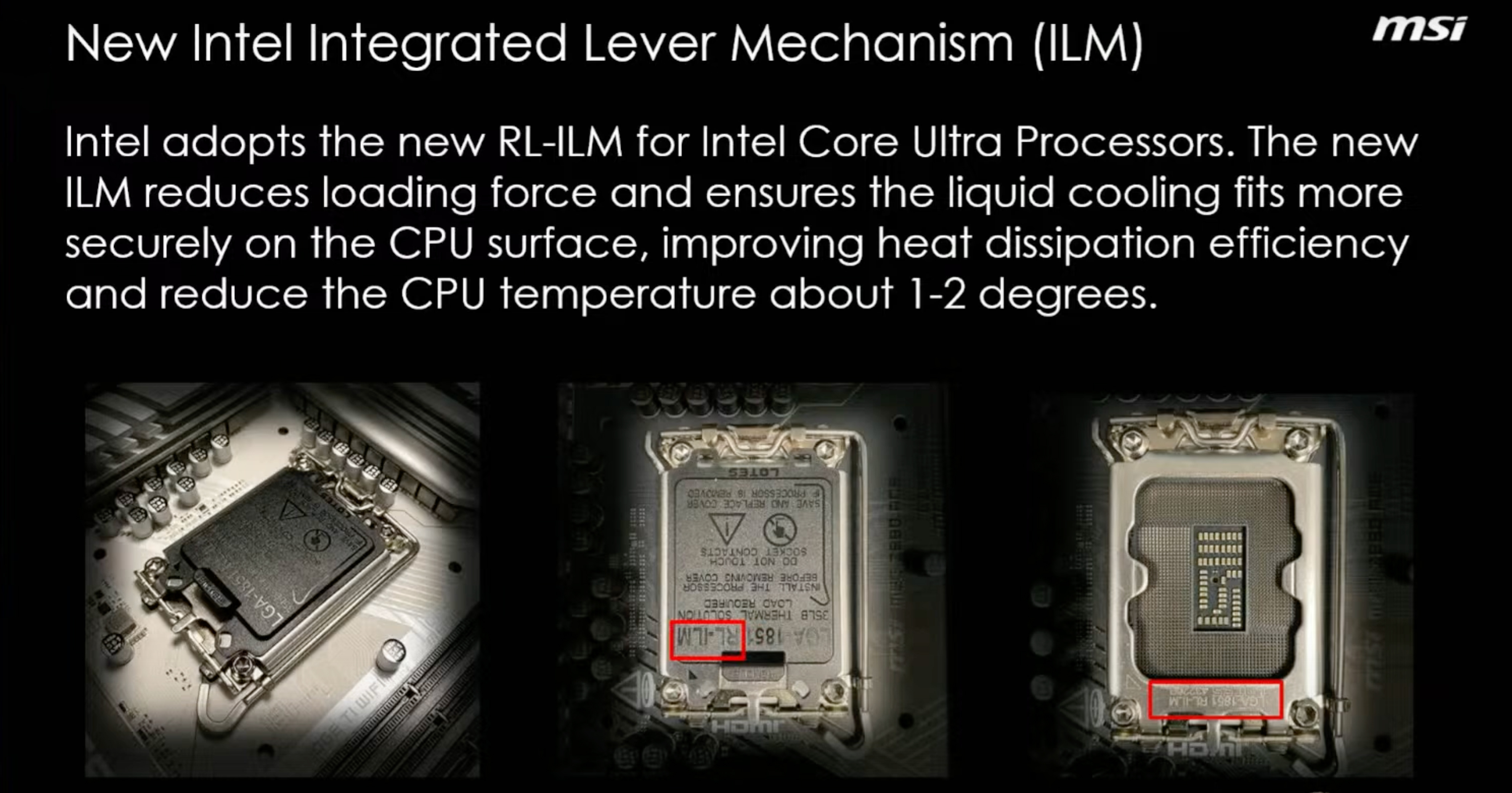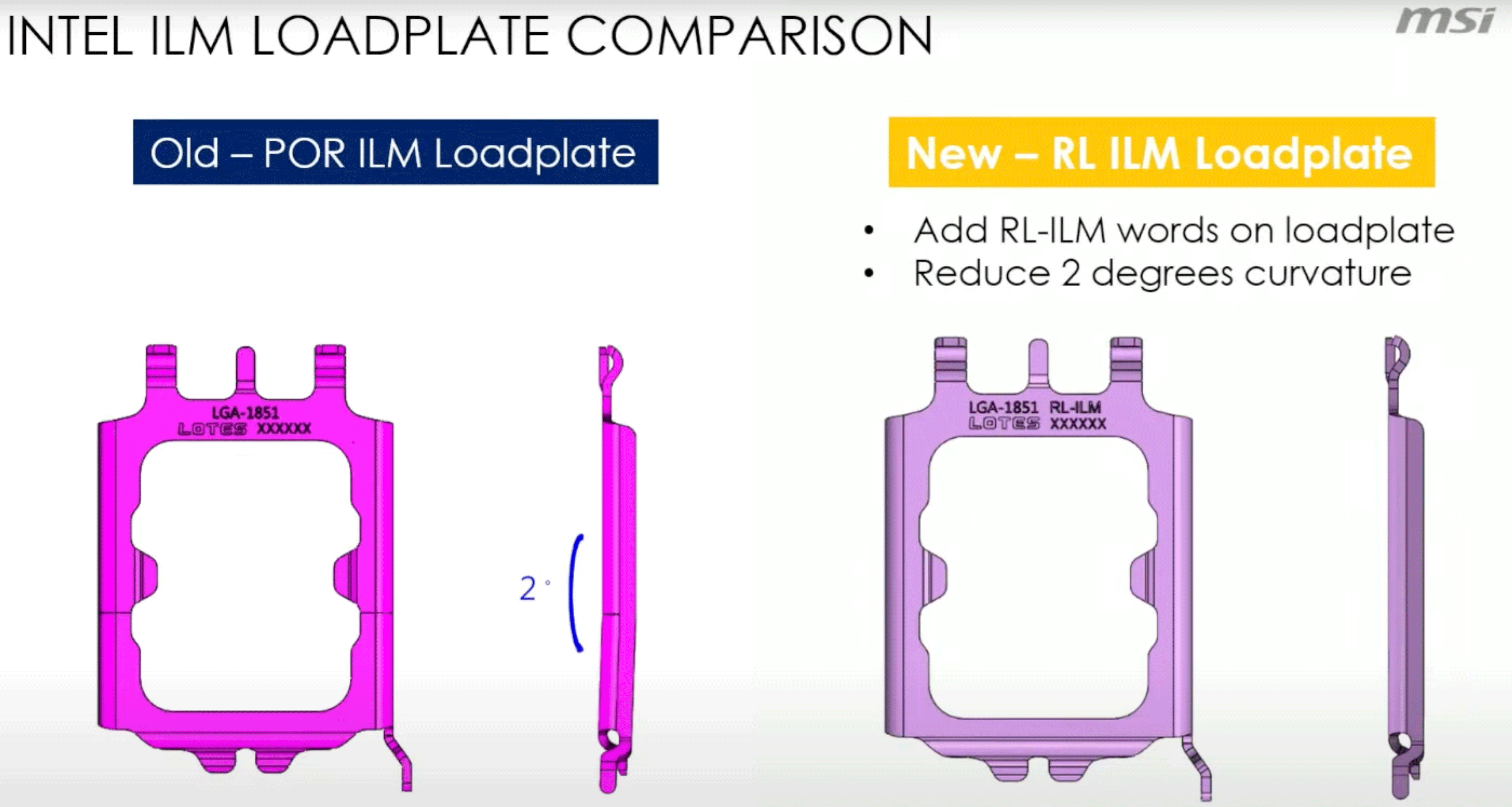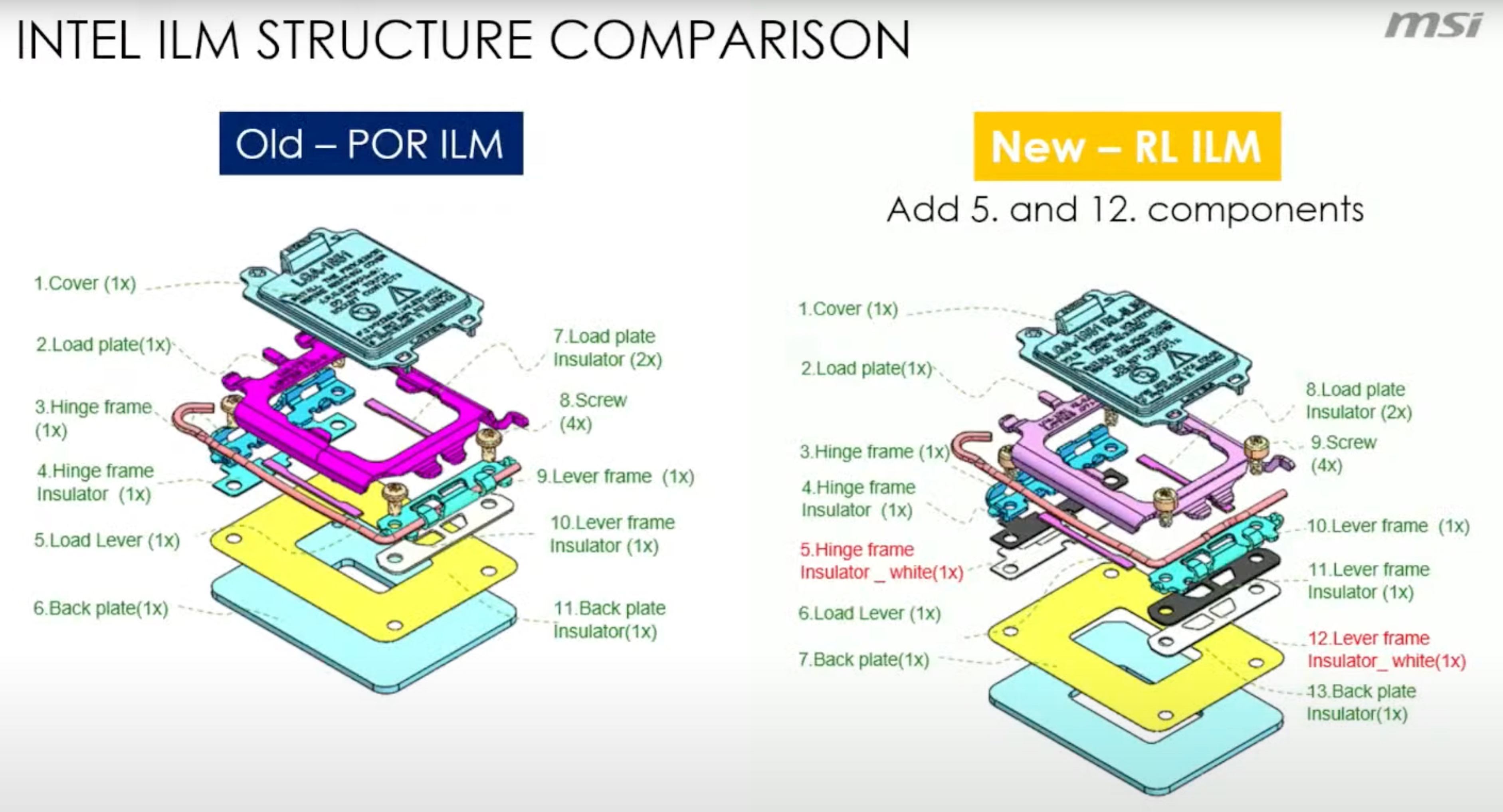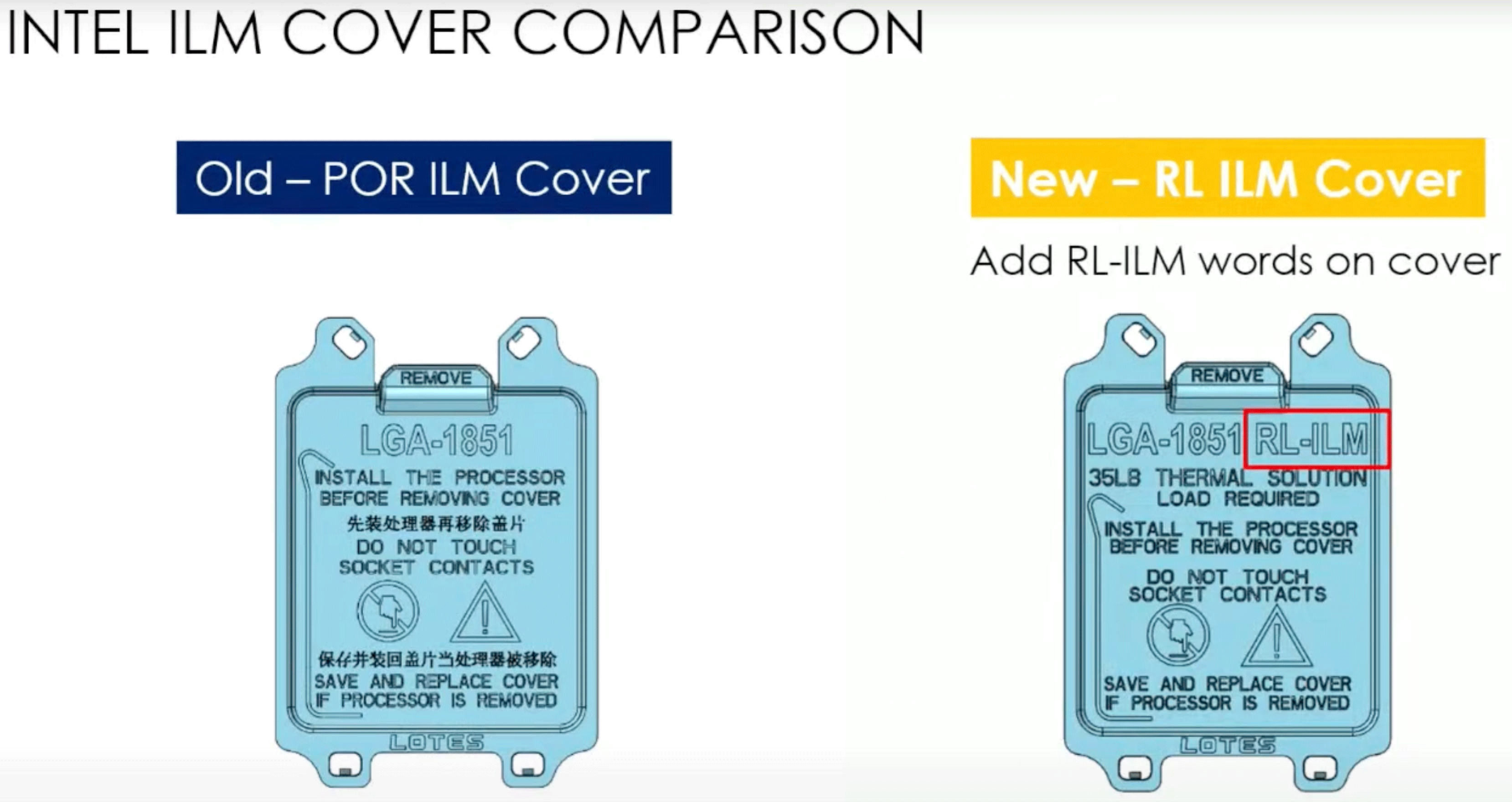Intel LGA1851 socket has a new ILM that helps CPUs run a bit cooler — MSI claims 1ºC to 2ºC lower CPU temperatures
A new flat load plate may help prevent CPU bending or at least reduce it.
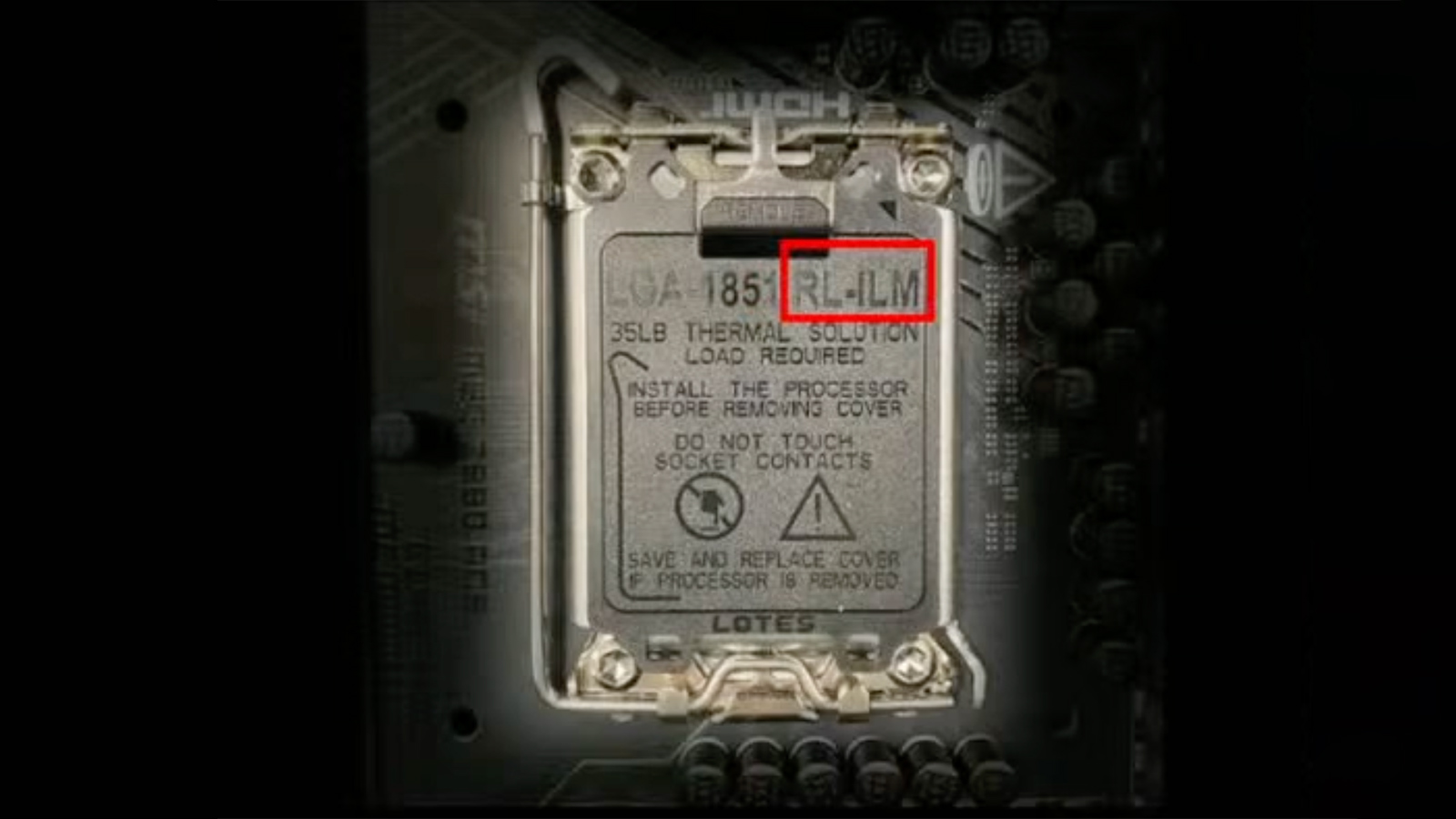
Intel's processors in LGA1700 packaging have faced serious criticism for bending and, therefore, insufficient cooling in some cases. With its Core Ultra 200S (codenamed Arrow Lake) processors in LGA1851 packaging, Intel not only moved the CPU hotspot north but also adopted a different integrated lever mechanism that improves compatibility with liquid coolers to lower thermals and uses a flat load plate, according to an MSI webcast.
"Intel adopts the new RL-ILM for Intel Core Ultra Processors," a statement by MSI reads. "The new ILM reduces loading force and ensures the liquid cooling fits more securely on the CPU surface, improving heat dissipation efficiency and reduce the CPU temperature about 1-2 degrees."
The new socket for LGA1851 processors uses a new RL-ILM, or integrated lever mechanism, the metallic bracket that holds the CPU in the socket. While the new IRL is not dramatically different from the one used with LGA1700 sockets and does not prevent the installation of previous-generation cooling systems (well, at least some of them), it has a lower loading force (which will reduce the chances of damaging Arrow Lake and other CPUs).
Perhaps more importantly, the new ILM also adopts a flat load plate (compared to a slightly curved load plate in the case of LGA1700 POR-ILM), which could address bending issues.
According to MSI, the new ILM offers better compatibility with liquid coolers, which helps lower CPU temperature by one to two degrees Celsius.
To achieve this, Intel had to add two extra components to the bracket's construction: an additional hinge frame insulator and a new lever frame insulator. While this makes the ILM slightly more complex, it helps cool down the CPU.
Also, the new flat load plate promises to circumvent CPU bending or at least reduce it. For some reason, MSI's webcast does not explicitly say this. Yet, since Intel's Arrow Lake processors use a multi-chiplet design, their bending could be devastating and kill these CPUs, so Intel had to alter the socket design.
Get Tom's Hardware's best news and in-depth reviews, straight to your inbox.
Intel's Core Ultra 200S Arrow Lake-S processors for desktops have just launched. In the coming weeks, we will learn more about their performance and the platform itself.

Anton Shilov is a contributing writer at Tom’s Hardware. Over the past couple of decades, he has covered everything from CPUs and GPUs to supercomputers and from modern process technologies and latest fab tools to high-tech industry trends.
-
KennyRedSocks "since Intel's Arrow Lake processors use a multi-chiplet design, their bending could be devastating and kill these CPUs, so Intel had to alter the socket design"Reply
As though Intel cares about that.
The greater the failure rate, the greater the sales. -
TheHerald Reply
Yes, of course they do. They are paying the RMAs from their own pocket man. What is that nonsense?KennyRedSocks said:"since Intel's Arrow Lake processors use a multi-chiplet design, their bending could be devastating and kill these CPUs, so Intel had to alter the socket design"
As though Intel cares about that.
The greater the failure rate, the greater the sales. -
JRStern >integrated lever mechanism -Reply
ILM
OK, the little socket locker widget thingy.
>the new ILM offers better compatibility with liquid coolers
liquid coolers, OMG
You mean, the chip runs so cold I can chill a beer on it, that would be awesome. -
YSCCC So this finally becomes official admission that the 1700 ILM is flawed and rectified, nice step forward.Reply -
TheHerald Reply
Yeap, 1-2c. Major flaw, lolYSCCC said:So this finally becomes official admission that the 1700 ILM is flawed and rectified, nice step forward. -
thestryker The RL-ILM is basically just a washer mod so if Intel really had a problem with the ILM they'd use one of the superior designs they used to have or design something entirely new. I imagine that this mechanism was largely driven by motherboard manufacturers who would rather people didn't remove the ILM.Reply
I doubt this will make any sort of substantial difference in operation on any of the boards it'll be installed on. The most likely place this would make a big difference would be on lower end boards that don't have as many layers/reinforced backplate. It will of course also make a difference when using a cooler that has a flatter coldplate though I imagine most people in that situation would have zero issues installing a contact frame. -
YSCCC Reply
You see, you adding your imagination again, nobody said it’s more than 1-2c average, from beginning, when igor invented washer mod, it’s all about the hot core hotspot throttling when load ramp up being unsuppressible, and it is something out of oridinary without any benefit, AKA, flawed.TheHerald said:Yeap, 1-2c. Major flaw, lol
Fun fact is all your claims about memory issues comes from ppl cannot tighten up the contact frames evenly and properly or over tighten one corner excessively, a lot of ppl successfully get same or better memory OC after using one. And basically none have issues using washer mod instead of the CF, which is what now Intel does. If the washer mod is only able to reduce the temp by 1-2C, IHS comes back to historical minor bend, and no adverse effects on OC, isn’t that a flaw fixed? MSI even showed the old ILM with stock base plate (part of ILM) under old design bends itself, so the old part, premium or cheap board all bends
Could be partly, but there are small differences here and there, more than the "simply a washer mod", like "Perhaps more importantly, the new ILM also adopts a flat load plate (compared to a slightly curved load plate in the case of LGA1700 POR-ILM)", and when I first learned about the 1700 bending (wasn't suspecting that sort of silly issue for Intel back then, I upgraded directly from Sandy Bridge to Alder Lake), what I was aware was it takes a lot more force to clamp it down compared to Sandy bridge. But on the various videos I looked, someone filmed the base plate, which is a 1mm thick metal visiabaly bends, if that bends, the extra 5 layers of PCB won't help, and even with a undeformable backplate on, the clamping force focused on the 2 fins on the IHS would be even higher as now the base plate didn't absorb part of the force applied, so the IHS and CPU PCB would defore more, not less.thestryker said:The RL-ILM is basically just a washer mod so if Intel really had a problem with the ILM they'd use one of the superior designs they used to have or design something entirely new. I imagine that this mechanism was largely driven by motherboard manufacturers who would rather people didn't remove the ILM.
I doubt this will make any sort of substantial difference in operation on any of the boards it'll be installed on. The most likely place this would make a big difference would be on lower end boards that don't have as many layers/reinforced backplate. It will of course also make a difference when using a cooler that has a flatter coldplate though I imagine most people in that situation would have zero issues installing a contact frame.
Into why they basically slightly modified the ILM vs re-do the design, it's an easy to make commercial choice.
1) The old LGA1700 ILM, though flawed, isn't something majorly impacting performance, momentarily throttling one core during sub second peak is more of a user comfort issue and say, maybe reduce things like R23 scores by 100 or so, so it isn't an major issue, but they can't roll out this back then, coz if they do, they will have to recall and replace all boards out there and the CPUs with extra deformation yet works.
2) As shown in the MSI slides, the RL-ILM did changed 3 (hinge frame insulator, load fram insulator and the load plate) out of 10 component (including the will be removed cover), so it's essentially re-designed or modified 30%, as for why not re-speccing all parts, it's simple, cost. both re-tooling and re-inventing the wheel, when during the 2.5 years+ of 1700 smart guys like Igor have did the R&D for them and in internal testing, it works, showing a constant improvement in temperature, less bending and no adverse effect on the CPU performance, why not just borrow the idea and add an extra improvement on new generation roll out? just don't use the washer from stores around the corner, make some proper parts to act the same and flattens the load frame and bam, weeks of R&D saved, temperature improved and ppl are happy. -
TheHerald The usual anti intel spill that flies against reality.Reply
Intel = Can casually cool over 320w with entry level cheap as hell air coolers and can cool over 360w with high end coolers
AMD = Can barely cool over 250w with the highest most expensive huge ass radiators.
Internet's conclusion, Intel's cooling solution has a major flaw cause with a custom modded ILM you can drop temperatures by 1C. And then people wonder why im defending intel. Cause of this crap I keep reading on the internet by amd fanatics. -
mangaTom Reply
I don't know if you're being disingenuous, don't know how current amd cpu works or just hate amd altogether. You do know it sets 95c as its target temperature and boosts the cpu as much as possible while maintaining that temp right? You can't even remove that temp limit in the bios. Also cooling an Intel cpu while it uses cheap air coolers? Yeah good luck with that. You'd probably thermal throttle before even reaching those power usage unless of course you increase your thermal limit and be comfortable with your CPU reaching 100+ degrees. Unless of course you break physics and somehow cool a cpu using 320w using an air cooler (probably rated at 200w or below) below 100c.TheHerald said:The usual anti intel spill that flies against reality.
Intel = Can casually cool over 320w with entry level cheap as hell air coolers and can cool over 360w with high end coolers
AMD = Can barely cool over 250w with the highest most expensive huge ass radiators.
Internet's conclusion, Intel's cooling solution has a major flaw cause with a custom modded ILM you can drop temperatures by 1C. And then people wonder why im defending intel. Cause of this crap I keep reading on the internet by amd fanatics. -
TheHerald Reply
That's just some excuse amd came up with. Every single CPU in the history of CPUs works exactly as zen 5 does. They keep boosting clocks until they hit a temperature, a voltage or a power limit. Zen 5 is just that bad at handling heat that it reaches the temperature limit first. If it was true that "it kept boosting until it hits 95c" that means that if I put it in the freezer it would boost to 8ghz and still hit 95c, which is just not true.mangaTom said:You do know it sets 95c as its target temperature and boosts the cpu as much as possible while maintaining that temp right?
My numbers came from TPUs cooler reviews.
https://www.techpowerup.com/review/id-cooling-dx-360-max-aio-liquid-cpu-cooler/7.html
Maximum heat capacity, 360w on Intel, 266w on AMD. Yet Intel's solution is considered "a major flaw". But im the hater here. Can you explain to me how a solution that is almost 40% better at dissipating heat than the competition is considered a major flaw? Im all ears. Really.
